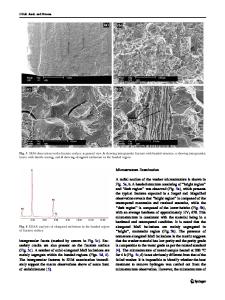Prevention of hydrogen embrittlement by a TiO 2 surface layer
- PDF / 739,173 Bytes
- 4 Pages / 594 x 774 pts Page_size
- 26 Downloads / 319 Views
The authors wish to acknowledge donation of the aluminum used in this work from ALCOA Research Center, Pittsburgh, PA, and the LiA1 master alloy from the Lithium Corporation of America, Bessemer City, NC. This work was funded by the National Science Foundation, grant #DMR-8212115.
REFERENCES 1. M.D. Hanna, Shu-Zu Lu, and A. Hellawell: Metall. Trans. A, 1984, vol. 15A, p. 459. 2. M. D. Hanna and A. Hellawell: Mat. Res. Soc. Symp. Proc., Elsevier Science Publishing Co., Inc., 1983, vol. 19, p. 411. 3. ASM Metals Handbook, 8th ed., 1973, vol. 8. 4. K.M. Myles, F.C. Mrazek, J.A. Smaga, and J.L. Settle: Proc. Symposium and Workshop on Advanced Battery Research and Design, ERDA ESC Report, ANL-76-8, Argonne National Laboratory, Argonne, IL, March 1976. 5. A. Hellawell: Progress in Materials Science, 1973, vol. 15, p. 1. 6. W.B. Pearson: Handbook of Lattice Spacings of Metals and Alloys, Pergamon Press, 1967, vol. 2, p. 571.
Prevention of Hydrogen Embrittlement by a Ti02 Surface Layer J. G. NELSON and G. T. MURRAY It is quite evident from recent review papers 1': that considerable effort has been spent on understanding the J.G. NELSON is with General Dynamics, San Diego, CA, and G. T. MURRAY is Professor and Acting Head, Metallurgical and Welding Engineering, California Polytechnic State University, San Luis Obispo, CA 93407. Manuscript submitted January 21, 1983. METALLURGICALTRANSACTIONS A
mechanisms of hydrogen embrittlement (HE) of steels. In comparison, however, relatively little effort has concentrated on prevention of HE, particularly by surface coatings. Preventive methods to date have largely been directed toward microstructure control. 3 Preventive methods in general, including surface coatings, have been recently reviewed by Pressouyre. 4 With respect to oxide coatings, it has been shown 5 that an aluminum-aluminum oxide surface coat on 321 stainless steel reduced significantly the permeability of hydrogen compared to uncoated steel. Vapor desposited titanium coated 304L stainless steel which had been exposed to air was not significantly embrittled when tested in high (69 MPa) pressure hydrogen, whereas uncoated specimens were embrittled. 6 Piggott and Siarkowski 7 demonstrated that thermally grown oxide films on 302 and 347 stainless steels were barriers to hydrogen infusion and that the diffusion coefficients for hydrogen through thin oxide films were of the order of 10-17 cm 2 s -1. More recently Van Deventer and Maroni 8 showed that thermally grown aluminum-containing oxide films on Fe-Cr-A1 alloys served to retard hydrogen permeation. Caskey 9 showed that the slow diffusion of hydrogen through rutile (TiO2) films on titanium was the dominant factor in predicting times for hydriding titanium. Others 1~ have demonstrated that titanium oxide films on titanium are effective barriers to hydrogen penetration. Because of the absence of data on prevention of HE by TiO2 films, and because of the data cited above that hydrogen diffusion in TiO2 films is very low, it was decided to explore the effect of a titanium
Data Loading...











